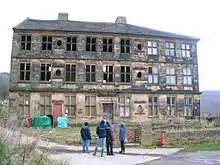Scout Hall
Scout Hall (also known as Scote Hall) at Shibden near Halifax, West Yorkshire, England, was built in 1681 for John Mitchell (1659–1696), who had inherited great wealth as a silk merchant.[1] Mitchell was castigated by the preacher Oliver Heywood for his dissolute way of life, spending his money on horse racing and drink. The house is a 'calendar' building, supposedly of 12 bays, with 52 doors and 365 panes of glass. It is Grade II* listed[2] but is on the English Heritage 'buildings at risk' register.[3]

The standing Scout Hall was built on the site of several earlier houses of the same name, the ancestral homes of the Stancliff(e), Otes, Savile and Waterhouse families[4] (Mitchell's wife was a Stancliff(e)). The name Stancliffe, or Stanclift, comes from the Old English for stone cliff.[5] The large homes named Scout Hall were all built near the base of a large stone cliff and a quarry from which the building stones were harvested.[6]
In 2010 it was put on the market for £350,000,[7] and later withdrawn, but has reputedly been sold[1] to someone who intends to restore it.
References
- "Scout Hall, Shibden". Malcolm Bull's Calderdale Companion. Retrieved 29 May 2015.
- Historic England. "Scout Hall (Grade II*) (1203783)". National Heritage List for England. Retrieved 29 May 2015.
- "Scout Hall, Lee Lane, Halifax – Calderdale". Heritage At Risk Register. English Heritage. Retrieved 29 May 2015.
- "Shibden Hall". Calderdale Council. Retrieved 29 May 2015.
- "Stancliff Family History". Ancestry.com. Retrieved 29 May 2015.
- Stancliff, Sherry Smith; Stancliff, Robert Claude (1995). Descendants of James Stanclift of Middletown, Connecticut and Allied Families. Cincinnati: S.S. Research.
- "Detached house for sale". Rightmove PLC. 6 October 2010. Retrieved 29 May 2015.